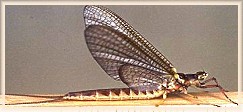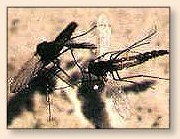Bug Latin Revisited
By Neil M. Travis, Montana
Alas it is true, the brown trout that is sipping insects from
the surface of your favorite trout stream does not know the
difference between Tricorythodes minutus or Tricorythodes
stygiatus. That rainbow trout that is slashing at the fluttering
caddis flies does not know the difference between Brachycentrus
americanus or Brachycentrus occidentalis. Given the relative size
of the brain of most salmonoids it seems unlikely that they posses
the necessary mental cognition to make the distinction even if they
had a desire to do so.

Alas it is equally true that anglers can, if they desire, make
the distinction between many of the various forms of insects.
When JC wrote about this subject recently he mentioned a 'fishing
buddy' that enjoyed making the distinction between the various
species of bugs and things. I am that 'fishing buddy'.. While taxonomy,
the orderly classification of plants and animals according to their
natural relationship, is not everyone's cup of tea it nonetheless
has a place and a purpose, even in the world of fly-fishing. Many
of the older writings that described various types of insects used
common or local names; names like March Brown, Blue Dun, Pale Watery
Dun, Great Red Spinner, and similar names. Today it is nearly impossible
to connect those names to any known insect thus rendering the information
about these insects useless for modern day anglers. It would be nice to
know if the Blue Dun hatch described by some 19th century writer is still
a viable hatch, and if the patterns they concocted to imitate it would
still be effective. Such is the importance of taxonomy.
All that having been said, it is totally true that trout cannot tell
the difference, and on a practical level if you call a fly a Blue Dun,
a Pale Watery Dun, or just a gray bug makes little or no difference.
If the fly you are using catches fish you can call it whatever you
want. However, I might purpose that a bit of scientific knowledge may
enhance your enjoyment of the sport of fly-fishing, and might even
increase your success.
Trout anglers deal with two basic types of insects; aquatic – those
that live in or hatch from the water, and terrestrial – those that
live on land and end up in or on the water. In the first group we
have four basic types; mayflies, caddis flies, stoneflies, and
midges. There are other types of aquatic insects upon which trout
feed, but these four basic types are the most common. It will
enhance your ability to catch trout if you can tell the difference
between the four basic types of trout stream insects.

Mayflies are the insects that most dry fly anglers associate with
fly-fishing, especially for trout. Mayflies range in size from 2
to 3 millimeters to giants measuring 40 to 50 millimeters. [One
millimeter equals 0.039 of an inch] They come in a variety of
colors, and are mostly found in cold water with high levels of
oxygen. They spend most of their lives as nymphs in streams or
still waters, and swim to the surface to hatch into the winged
form. Most species undergo a second molting process before they
are capable of breeding. Anglers call the hatching insects 'duns'
and the egg laying adults 'spinners.' All that you have to know
about mayflies is that the wings of the adults are held upright
over the body when the insect is at rest, much like a butterfly.
If you see some insects floating on your local trout water with
wings held upright over their bodies it is likely that you are
observing a hatch of mayflies.

Like mayflies, caddis flies spend most of their lives underwater.
Unlike mayflies, once they hatch they do not undergo any further
transformations. Caddis fly larvae look like worms, and many of
them construct cases that serve as protection during this stage
of their lives. Like butterflies, when the larvae are fully-grown
they spin a cocoon, usually inside their case, and make the
transformation from larvae to adult. When they hatch they swim
vigorously to the surface and rapidly fly away. Some species run
across the surface of the water after they hatch, which makes for
some exciting strikes. Caddis flies fold their wings over their
bodies like a tent, and have a strong resemblance to terrestrial
moths. During the course of the season many trout waters will have
very heavy hatches of caddis flies, making them one of the more
important insects for the trout angler to be familiar with.

In general, stonefly nymphs require waters with very high oxygen
content, which limits most species to very cold water. For most
anglers stoneflies are the least important aquatic insect, and
except for such well-known hatches as the famous Salmon Fly,
Golden Stone, and the diminutive Yellow Sally most anglers will
seldom encounter a fishable hatch of these flies. Stonefly nymphs
are squat flat insects ideally adapted to the type of water where
they are generally found. When they are ready to hatch most species
crawl to the bank, emerge from the water, and hatch on dry land.
They only return to the water to lay their eggs. Stoneflies fold
their wings flat over their back when at rest. Some species of
stoneflies, like the Salmon fly, can be two inches long, and when
they are available can provide some of the most outstanding dry
fly fishing. Some of the largest trout that are taken on dry flies
are caught on patterns imitating these flies.
On most trout waters midges are the most common aquatic insects.
They can be found hatching every month of the year unless the
water is completely frozen. In the course of the year they hatch
in untold millions, and provide a very critical food source for
many species of fish. Midges belong to family of insects that
include such favorites as mosquitoes, black flies, no-see-um's,
and houseflies. Many an unfortunate midge has been slapped flat
by someone that thought it was a blood-sucking mosquito.
 True midges are benign, having no biting mouthparts with which to
extract your blood. While most midges are quite small, lake
midges, often called Chironomids, can be quite large with some
imitations being tied on a size 10 hook. If you can identify a
mosquito you know what an adult midge looks like. The larval form
looks like a worm, and the pupa resembles a worm with a large head.
The adults hatch from the water, form large swarms over nearby
areas, and return to the water to lay their eggs. The larva and
pupa are of greatest importance to anglers, but fishing to trout
rising to the adults is some of the most demanding and exacting
dry fly angling available.
True midges are benign, having no biting mouthparts with which to
extract your blood. While most midges are quite small, lake
midges, often called Chironomids, can be quite large with some
imitations being tied on a size 10 hook. If you can identify a
mosquito you know what an adult midge looks like. The larval form
looks like a worm, and the pupa resembles a worm with a large head.
The adults hatch from the water, form large swarms over nearby
areas, and return to the water to lay their eggs. The larva and
pupa are of greatest importance to anglers, but fishing to trout
rising to the adults is some of the most demanding and exacting
dry fly angling available.
Terrestrial insects include everything else, and to describe them
all would require several large volumes. If it lives on land, finds
its way into the water, a trout may eat it, and if you can imitate
you just might catch them.
If you want to successfully imitate a specific insect that you see
trout feeding on it's really quite simple. Pick one up, look at it,
notice its size and general color, watch how it acts on the water,
and then fish something that has that general shape and overall
color. If your imitation looks edible to the trout, and it is
presented properly the trout will likely take a shot at it. If
you know the name of the bug good for you, if you catch the trout
and don't have the slightest idea what type of bug you were imitating
that's even better, unless you are going to write a book about trout
stream insects. ~ Neil M. Travis, Montana/Arizona
From A Journal Archives
|

